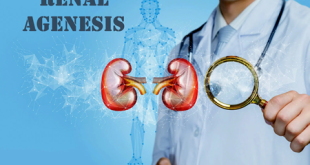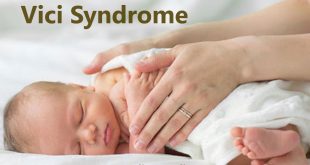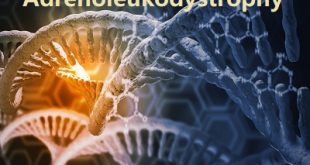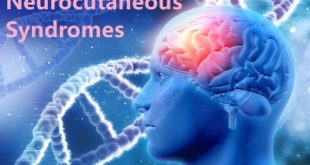Definition
Niemann-Pick disease (NPD) is a group of inherited metabolic disorders in which harmful quantities of a fatty substance (lipids) accumulate in the spleen, liver, lungs, bone marrow, and brain. There is a deficiency of a lysosomal enzyme called acid sphingomyelinase or disturbance in cholesterol breakdown or transportation. This enzyme is responsible for the proper metabolism of lipids and lack of it affects lipid metabolism. Symptoms may include lack of muscle coordination, brain degeneration, learning problems, loss of muscle tone, increased sensitivity to touch, spasticity, feeding and swallowing difficulties, slurred speech, and an enlarged liver and spleen. Inheritance is autosomal recessive.
Baby affected with the Niemann-Pick disease
History
Albert Niemann published the first description of what now is known as Niemann–Pick disease, type A, in 1914. Ludwig Pick described the pathology of the disease in a series of papers in the 1930s.
In 1961, the classification of Niemann–Pick disease into types A, B, and C was introduced, and also contained a type D, called the “Nova Scotian type”. Genetic studies showed that type D is caused by the same gene as type C1, and the type D designation is no longer used.
Epidemiology
The incidence among Ashkenazi Jews is estimated to be about one in 40,000 for type A of Niemann–Pick disease. The incidence of both Niemann–Pick disease types A and B in all other populations is estimated to be one in 250,000. The incidence of Niemann–Pick disease type C is estimated to be one in 150,000.
Types
Niemann-Pick disease is divided into four main types according to the altered (mutated) gene and the signs and symptoms:
Type A: Caused by mutations in the SMPD1 gene. It is the most severe form, occurs in early infancy and is seen primarily in Jewish families.
Type B: Caused by mutations in the SMPD1 gene. Usually occurs in children, and affects the liver, spleen and lungs (visceral form), but generally does not affect the brain.
Type C1: Caused by mutations in the NPC1 gene. May occur at any age and affect the brain and the viscera.
Type C2: caused by homozygous mutation in the NPC2 gene. Similar to type C1, but more severe, and mostly affecting the lungs.
Some classify type A and B as “acid sphingomyelinase (ASM) deficiency”. NP type D is now considered as type C (when affected people are from Nova Scotia, Canada); other rarer types have been described.
Risk factors of Niemann-Pick Disease
- Genetic mutations – Niemann-Pick disease types A and B are caused by a mutation in the SMPD1 gene while Type C is caused by the mutation in NPC1 (95% cases) or NPC2 (5% cases) genes
- Consanguinity
- Family history – in families with an affected child, there will be 25% chance of being affected, a 50% chance of being an asymptomatic carrier, and 25% chance of being unaffected and not a carrier.
Causes
- NPD types A and B occur when cells in the body do not have an enzyme called acid sphingomyelinase (ASM). This substance helps break down (metabolize) a fatty substance called sphingomyelin, which is found in every cell in the body.
- If ASM is missing or does not work properly, sphingomyelin builds up inside cells. This kills your cells and makes it hard for organs to work properly.
- Type A occurs in all races and ethnicities. It is more common in the Ashkenazi (Eastern European) Jewish population.
- Type C occurs when the body cannot properly break down cholesterol and other fats (lipids). This leads to too much cholesterol in the liver and spleen and too much of other lipids in the brain. Type C is most common among Puerto Ricans of Spanish descent.
- Type C1 is a variant of type C. It involves a defect that interferes with how cholesterol moves between brain cells. This type has only been seen in French Canadian people in Yarmouth County, Nova Scotia.
Symptoms of Niemann-Pick Disease
Symptoms vary. Other health conditions may cause similar symptoms. The early stages of the disease may only cause a few symptoms. A person may never have all symptoms.
Type A usually begins in the first few months of life.
Symptoms may include:
- Abdominal (belly area) swelling within 3 to 6 months
- Cherry red spot at the back of the eye (on the retina)
- Feeding difficulties
- Loss of early motor skills (gets worse over time)
Type B symptoms are usually milder. They occur in late childhood or the teenage years. Abdominal swelling may occur in young children. There are almost no brain and nervous system involvement, such as loss of motor skills. Some children may have repeated respiratory infections.
Types C and C1 usually affect school-age children. However, it may occur any time between early infancy to adulthood. Symptoms may include:
Difficulty moving limbs that may lead to the unsteady gait, clumsiness, walking problems
- Enlarged spleen
- Enlarged liver
- Jaundice at (or shortly after) birth
- Learning difficulties and intellectual decline
- Seizures
- Slurred, irregular speech
- Sudden loss of muscle tone that may lead to falls
- Tremors
- Trouble moving the eyes up and down
Complications of Niemann-Pick Disease
- Patients with Niemann-Pick disease (NPD) should regularly visit their doctor in order to treat and help prevent complications of NPD. Patients with NPD should avoid contact sports because of the risk of rupture of the spleen.
- Patients with NPD type B are at an increased risk to develop liver failure and/or respiratory problems, which put stress on the heart and may ultimately lead to heart disease.
- Removal of the spleen should be avoided, as it leads to rapid progression of lung disease.
- Lung disease is progressive in patients with NPD type B and may result in supplemental oxygen being administered.
- Other complications include blindness, brain damage with mental retardation and delayed development of physical skills, deafness, and death.
Diagnosis and test
Biochemical testing – Acid Sphingomyelinase activity of <10% in peripheral blood lymphocytes or cultured skin fibroblasts confirms the diagnosis.
Bone Marrow Examination – Presence of lipid-laden macrophages
Molecular testing
- Sequence analysis of the SMPD1 mutation in 99% cases
- Targeted mutation analysis for NPD-A & NPD-B mutations
Prenatal testing
Ultrasound can detect the enlarged liver and spleen that’s caused by type C. And amniocentesis or chorionic villus sampling may be used to confirm a diagnosis of Niemann-Pick.
Magnetic resonance imaging (MRI)
An MRI of the brain may show loss of brain cells. But in the early stages of Niemann-Pick, an MRI may be normal because symptoms typically occur before the loss of brain cells.
Treatment and medications
General: There is no cure or specific treatment for the Niemann-Pick disease (NPD). Instead, treatment focuses on reducing the symptoms and delaying the onset of the disease if it is diagnosed early enough. A healthy, low-cholesterol diet is recommended, although research does not show that this diet slows the progression or cures NPD.
NPD type A: There is no known treatment for NPD type A. Most patients die before 18 months of age. Supportive treatment can be given to managing the symptoms of NPD type A. A multidisciplinary team including pulmonologists, cardiologists, liver and spleen specialists, nutritionists, physical therapists, and a gastroenterologist may be needed.
NPD types B and C: Individuals with NPD types C and D are frequently placed on a low-cholesterol diet. However, this has not been proven to be clinically beneficial. Medications may be prescribed to control or relieve symptoms, such as seizures.
Bone marrow transplantation has been attempted in a few patients with NPD type B, with limited success due to complications. Clinical trials are ongoing for enzyme replacement therapy in adult patients with non-neurological NPD type B. Another promising treatment for late-onset NPD is to replace the mutant genes with healthy ones using gene therapy. The administration of neurosteroids, which are hormones found in the nervous system that are essential for proper brain function, also shows promise as a future treatment for NPD type B.
Canada has announced its approval of Zavesca (miglustat) for the treatment of neurological symptoms of NPD type C, it is not a cure, but it has shown benefits in managing symptoms and slowing the progression of NPD type C
Prevention of Niemann-Pick Disease
- Families can be offered genetic counselling.
- Prenatal diagnosis is feasible in many cases. This is generally accurate for types A and B but more difficult for type C.
- Carrier testing is usually only possible once there is an affected person in the family when the gene mutation can be identified. The exception is the known mutations of the NPA gene in certain communities – eg, Ashkenazi Jews. Awareness of NPA is relevant to these populations.
 Diseases Treatments Dictionary This is complete solution to read all diseases treatments Which covers Prevention, Causes, Symptoms, Medical Terms, Drugs, Prescription, Natural Remedies with cures and Treatments. Most of the common diseases were listed in names, split with categories.
Diseases Treatments Dictionary This is complete solution to read all diseases treatments Which covers Prevention, Causes, Symptoms, Medical Terms, Drugs, Prescription, Natural Remedies with cures and Treatments. Most of the common diseases were listed in names, split with categories.







